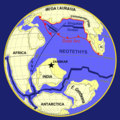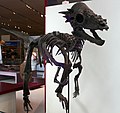The Cretaceous–Paleogene (K–Pg) extinction event, formerly known as the Cretaceous-Tertiary (K–T) extinction event, was the mass extinction of three-quarters...
198 KB (21,860 words) - 04:42, 15 July 2025
amount of research has been conducted on the Cretaceous–Paleogene extinction event, the mass extinction that ended the dinosaur-dominated Mesozoic Era...
120 KB (12,558 words) - 19:46, 5 July 2025
043 Ma. The K–Pg boundary is associated with the Cretaceous–Paleogene extinction event, a mass extinction which destroyed a majority of the world's Mesozoic...
30 KB (3,118 words) - 12:49, 9 June 2025
early Paleogene, as survivors of the Cretaceous–Paleogene extinction event took advantage of empty ecological niches left behind by the extinction of the...
69 KB (7,550 words) - 10:38, 16 July 2025
Cretaceous (along with the Mesozoic) ended with the Cretaceous–Paleogene extinction event, a large mass extinction in which many groups, including non-avian dinosaurs...
96 KB (9,996 words) - 06:53, 21 July 2025
impact event may have caused the Cretaceous–Paleogene extinction has led to speculation that similar impacts may have been the cause of other extinction events...
389 KB (41,157 words) - 01:57, 13 July 2025
impact 66 million years ago, believed to be the cause of the Cretaceous–Paleogene extinction event. Small objects frequently collide with Earth. There is an...
117 KB (12,843 words) - 17:20, 19 June 2025
Danian (section Latest Danian Event)
(and the end of the preceding Maastrichtian) is at the Cretaceous–Paleogene extinction event 66 Ma. The age ended 61.66 Ma, being followed by the Selandian...
14 KB (1,393 words) - 06:51, 8 June 2025
was wiped out in the Cretaceous-Paleogene extinction event; only 3 extant tetrapod lineages can trace their ancestry to Cretaceous India. Most of India's...
30 KB (3,772 words) - 06:50, 3 July 2025
Ammonoidea (category Paleocene extinctions)
with the last species vanishing during or soon after the Cretaceous–Paleogene extinction event (66 million years ago). They are often called ammonites...
55 KB (6,008 words) - 16:31, 12 July 2025
Mesozoic (section Cretaceous)
extinction event, the largest mass extinction in Earth's history, and ended with the Cretaceous–Paleogene extinction event, another mass extinction whose...
41 KB (4,430 words) - 08:44, 1 July 2025
dinosaur such as Stenonychosaurus had not perished in the Cretaceous–Paleogene extinction event, its descendants might have evolved to fill the same ecological...
10 KB (1,135 words) - 06:12, 4 July 2025
mass extinctions have significantly exceeded the background extinction rate. The most recent and best-known, the Cretaceous–Paleogene extinction event, which...
150 KB (15,140 words) - 01:52, 12 July 2025
willows could be found in abundance. The Cretaceous–Paleogene extinction event was a large-scale mass extinction of animal and plant species in a geologically...
18 KB (1,694 words) - 08:48, 1 July 2025
Chicxulub crater (category Cretaceous–Paleogene boundary)
resulting from the impact was the primary cause of the Cretaceous–Paleogene extinction event, a mass extinction of 75% of plant and animal species on Earth, including...
85 KB (8,270 words) - 09:24, 15 July 2025
ecological impacts associated with the Permian–Triassic and Cretaceous–Paleogene extinction events. Furthermore, biotic recovery from LOME proceeded at a much...
103 KB (11,116 words) - 03:20, 18 July 2025
years ago. The period began with the extinction of the non-avian dinosaurs in the Cretaceous–Paleogene extinction event, at the start of the Cenozoic Era...
11 KB (983 words) - 10:52, 24 June 2025
species, Triceratops prorsus, became extinct during the Cretaceous–Paleogene extinction event, 66 million years ago. Triceratops is by far the best-known...
32 KB (2,976 words) - 03:34, 14 July 2025
Alvarez hypothesis (redirect from Alvarez extinction hypothesis)
posits that the mass extinction of the non-avian dinosaurs and many other living things during the Cretaceous–Paleogene extinction event was caused by the...
21 KB (2,447 words) - 21:30, 12 July 2025
Titanoboa (category Paleogene Colombia)
following the extinction of all non-avian dinosaurs, being one of the largest reptiles to evolve after the Cretaceous–Paleogene extinction event. Its vertebrae...
30 KB (3,390 words) - 18:57, 13 July 2025
Maastrichtian (category Late Cretaceous)
province in the Netherlands. The Cretaceous–Paleogene extinction event (formerly known as the Cretaceous–Tertiary extinction event) occurred at the end of this...
20 KB (1,824 words) - 20:46, 4 July 2025
the Triassic–Jurassic extinction event. While other crocodylomorph groups further survived the Cretaceous–Paleogene extinction event, only the crocodilians...
119 KB (13,621 words) - 00:55, 14 July 2025
last species of non-avian dinosaurs on Earth before the Cretaceous–Paleogene extinction event. The genus Tylosteus has been synonymized with Pachycephalosaurus...
51 KB (5,131 words) - 06:20, 13 July 2025
Earth, complete with animals and ecosystems, where the Cretaceous-Paleogene extinction event never occurred, leaving non-avian dinosaurs and other Mesozoic...
15 KB (1,645 words) - 22:11, 8 May 2025
Archosaur (section Extinction and survival)
the Cretaceous–Paleogene extinction event (~66 Ma). Birds and several crocodyliform lineages were the only archosaurs to survive the K-Pg extinction, rediversifying...
58 KB (5,566 words) - 17:40, 22 June 2025
invertebrates during the Capitanian mass extinction was comparable in magnitude to the Cretaceous–Paleogene extinction event. Some studies have considered it...
73 KB (7,725 words) - 06:04, 30 June 2025
Geomagnetic reversal (redirect from Cretaceous Long Normal)
impact events is weak. There is no evidence for a reversal connected with the impact event that caused the Cretaceous–Paleogene extinction event. Shortly...
44 KB (4,927 words) - 22:18, 7 May 2025
dinosaurs alive at the time, the titanosaurs died out in the Cretaceous–Paleogene extinction event. Fossilised remains of sauropods have been found on every...
89 KB (9,878 words) - 18:59, 18 July 2025
various neoavian groups occurred very rapidly around the Cretaceous–Paleogene extinction event, and attempts to resolve their relationships with each other...
30 KB (1,325 words) - 07:35, 2 June 2025























